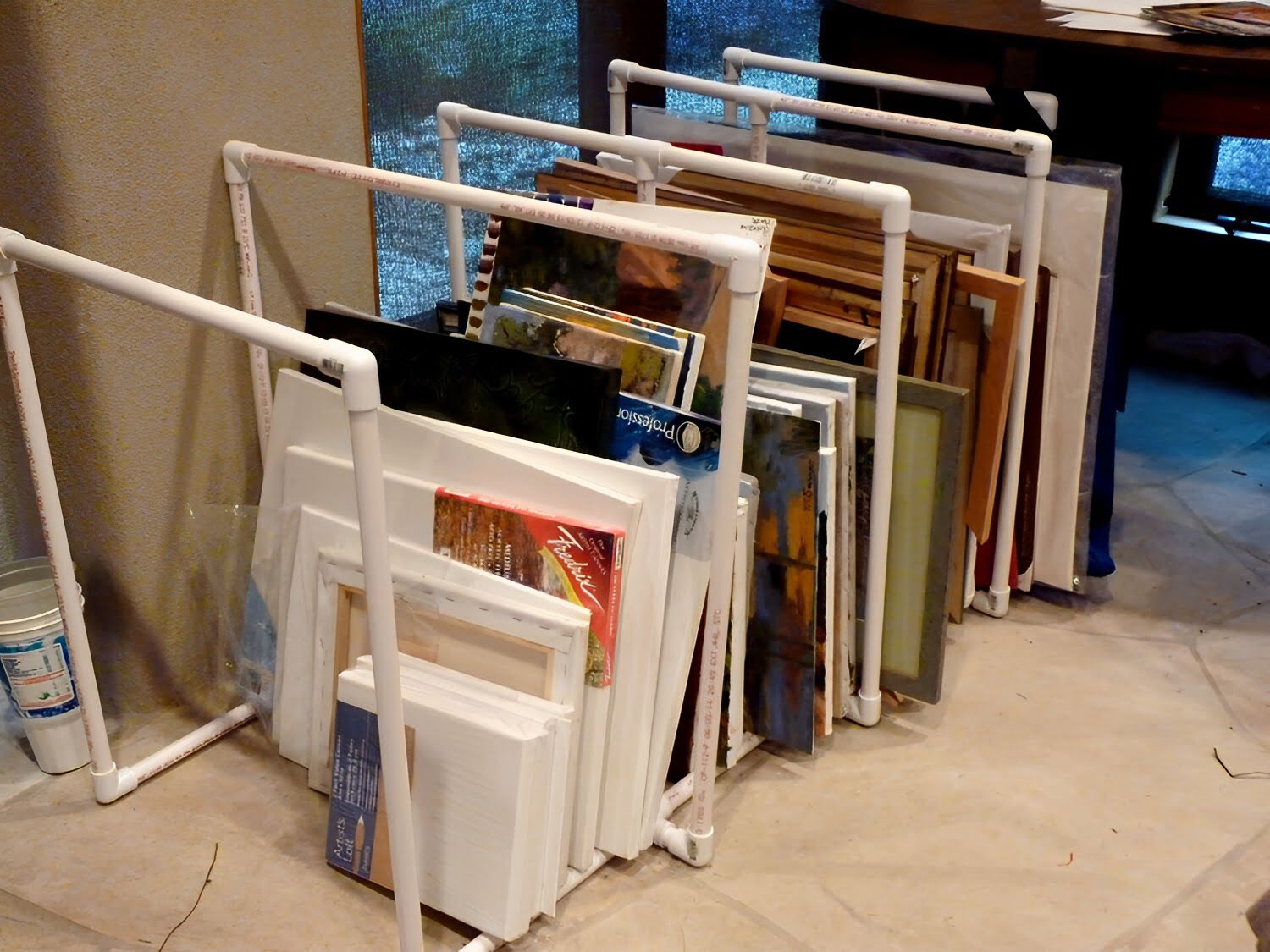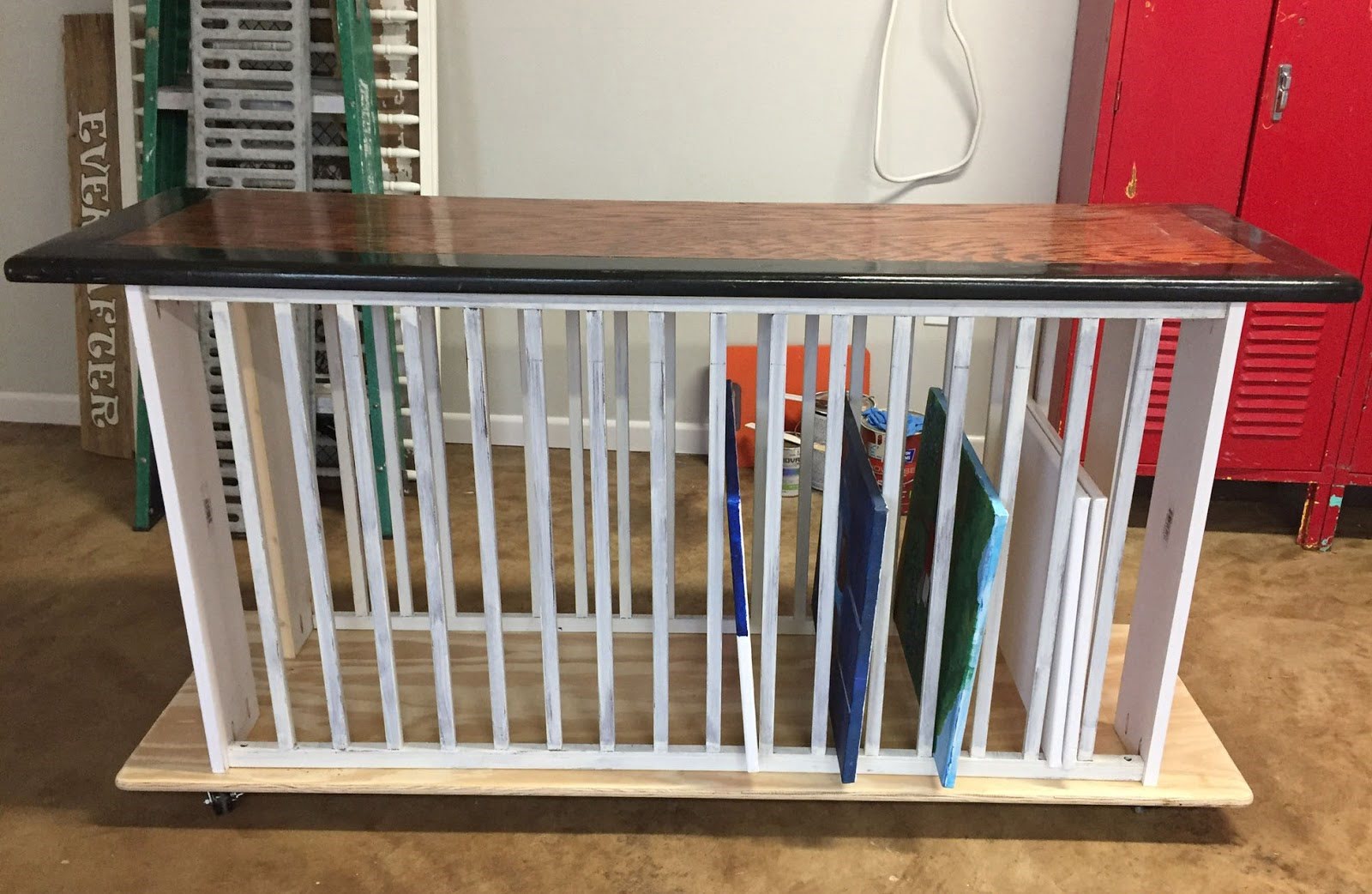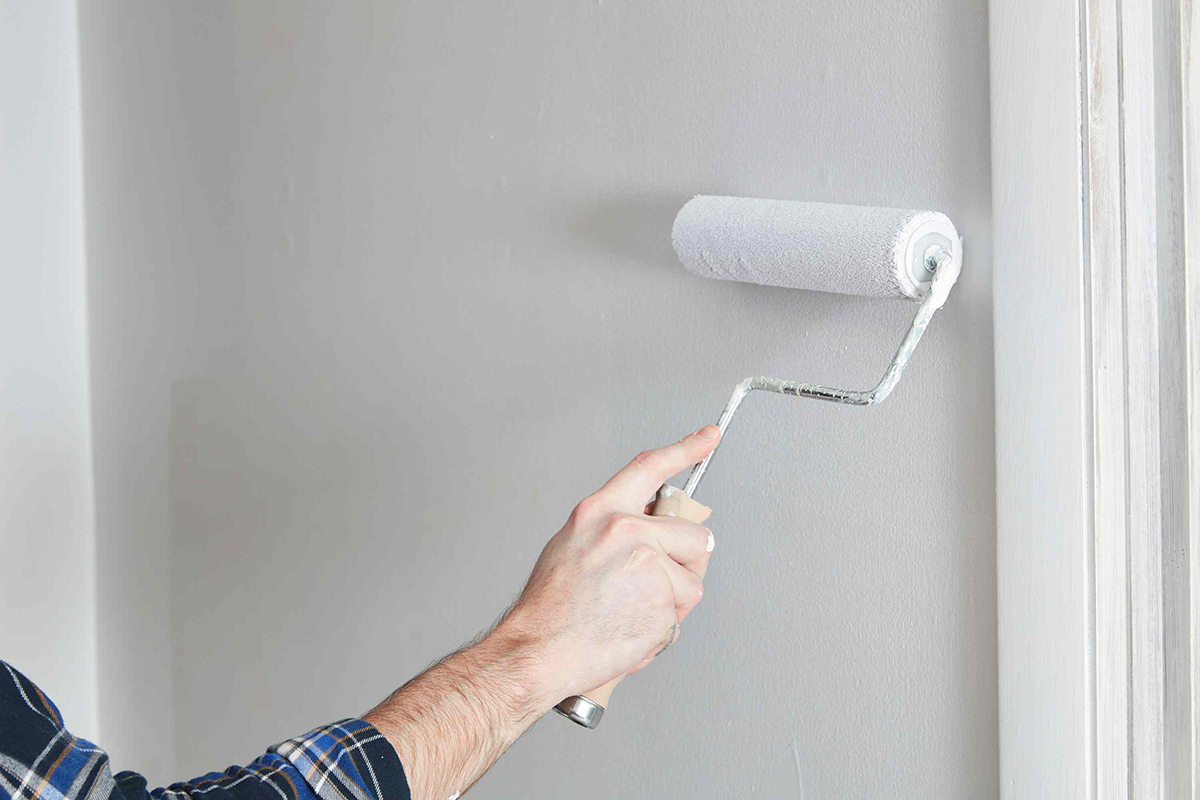

Articles
How To Store Canvas Paintings At Home
Modified: May 6, 2024
Learn the best practices for storing canvas paintings at home. Our articles provide tips and guidelines for preserving your precious artworks.
(Many of the links in this article redirect to a specific reviewed product. Your purchase of these products through affiliate links helps to generate commission for Storables.com, at no extra cost. Learn more)
Introduction
Storing canvas paintings at home requires proper care and attention to ensure their longevity and preservation. Whether you have valuable art pieces or sentimental paintings, it’s essential to create a suitable storage environment to protect them from damage. In this article, we will discuss the steps you need to take to store canvas paintings at home effectively.
Canvas paintings are delicate and susceptible to various factors that can cause deterioration, such as moisture, temperature fluctuations, light exposure, and physical damage. By following the right techniques for storage, you can maintain the quality and beauty of your artwork for years to come.
Before you begin, consider the importance of investing time and effort into proper storage. Preserving your canvas paintings not only protects their value but also allows you to enjoy them for generations. Whether you are an art enthusiast, collector, or someone who cherishes personal artwork, these tips will guide you in preserving your precious canvas paintings.
Key Takeaways:
- Proper storage of canvas paintings at home involves choosing the right space, preparing the area, cleaning the paintings, and protecting them from environmental factors. Investing in these preservation techniques ensures the longevity and value of your artwork.
- By carefully selecting the storage space, using acid-free materials, avoiding direct sunlight, and regularly maintaining the storage area, you can safeguard your canvas paintings from damage and preserve their beauty for generations to come.
Read more: How To Store Canvas Paintings
Choosing the Right Storage Space
When it comes to storing canvas paintings at home, selecting the right storage space is crucial. Here are some factors to consider:
- Climate Control: Look for a storage area that has a controlled climate. Extreme temperature fluctuations and high humidity can cause damage to the canvas and paint. Ideally, the storage space should maintain a temperature between 65-75 degrees Fahrenheit and a humidity level around 40-50%. This will help prevent the canvas from warping and protect the paint from cracking or peeling.
- Lighting: Choose a storage area that is away from direct sunlight or harsh artificial light. Ultraviolet (UV) rays can cause fading and discoloration of the painting over time. If natural light is inevitable, consider using UV-filtering window treatments or placing a protective covering over the painting.
- Security: Ensure the storage space is secure and protected from potential theft or damage. Install proper locks, security systems, and consider storing valuable paintings in a locked cabinet or safe.
- Clearance: The storage area should have sufficient space to accommodate the size and quantity of your canvas paintings. Adequate clearance around each painting will help prevent accidental damage.
- Accessibility: Consider how easily you can access the paintings when needed. If you plan to rotate your artwork or showcase them periodically, ensure the storage space allows for easy retrieval without the risk of damaging other pieces.
- Avoid High Traffic Areas: Steer clear of storing canvas paintings in areas with high foot traffic or where they can be easily bumped or knocked over. Choose a dedicated storage space that provides the least risk of accidental damage.
By carefully selecting the right storage space, you can significantly reduce the risk of damage to your canvas paintings. It’s important to prioritize climate control, lighting, security, and accessibility to ensure the longevity and preservation of your artwork.
Preparing the Storage Area
Once you have chosen the appropriate storage space for your canvas paintings, it is essential to prepare the area to create an optimal environment for their preservation. Here are some steps to follow:
- Clean and Dust: Start by thoroughly cleaning the storage area. Remove any dust, dirt, or debris that could potentially come into contact with the paintings. Use a soft, lint-free cloth or a microfiber duster to gently clean the surfaces and corners of the storage space.
- Avoid Excessive Moisture: Ensure that the storage area is dry and free from excessive moisture. Moisture can promote the growth of mold and mildew, which can cause irreparable damage to the canvas and paint. Consider using dehumidifiers or moisture-absorbing products, especially in areas with high humidity.
- Inspect for Pests: Check the storage space for any signs of pests, such as rodents or insects, which can cause significant damage to your artwork. Seal any cracks or openings that may serve as entry points for pests and consider using pest control measures if necessary.
- Remove Hazards: Remove any potential hazards from the storage area, such as sharp objects, liquids, or chemicals. These can pose a risk of accidental damage to the paintings.
- Organize and Label: Keep your storage area organized by arranging paintings in a logical order. Consider labeling or categorizing them by artist, size, or theme to make retrieval easier and prevent unnecessary handling of other paintings.
- Consider Shelving or Racks: To maximize space and protect your paintings, consider investing in sturdy shelving or racks designed specifically for artwork storage. These will help keep the paintings upright and minimize the risk of leaning or falling.
- Fire Safety: Ensure that the storage area is equipped with proper fire safety measures, such as fire extinguishers and smoke detectors. Regularly check these devices to ensure they are in good working condition.
By taking the time to prepare the storage area properly, you can minimize the risk of potential damage to your canvas paintings. A clean, organized, and hazard-free storage environment will contribute to the long-term preservation and protection of your valued artwork.
Cleaning the Canvas Painting
Before storing your canvas paintings, it is crucial to clean them properly to remove any dirt or dust that may have accumulated over time. Here’s how you can safely clean your canvas paintings:
- Dry Dusting: Start by gently brushing the surface of the painting with a soft, clean brush or a microfiber cloth. Use light and sweeping motions to remove loose dust and dirt. Be careful not to apply excessive pressure to avoid damaging the canvas or paint.
- Spot Cleaning: If you notice any stubborn stains or spots on the painting, you can attempt to spot clean them. Dampen a clean cloth or sponge with distilled water or a mild cleaning solution specifically formulated for delicate artwork. Gently dab the stained area, being careful not to rub or scrub vigorously.
- Testing First: Before applying any cleaning solution or water directly to the painting, perform a spot test on an inconspicuous area. Apply a small amount of the cleaning solution and gently blot with a cloth. If the colors or paint start to bleed or transfer, stop immediately and consult a professional art conservator.
- Avoid Harsh Chemicals: Steer clear of using harsh cleaning agents, solvents, or household chemicals on your canvas paintings. These can cause irreversible damage to the paint and canvas. Stick to mild, pH-neutral cleaning solutions or distilled water.
- Handling with Care: When cleaning your canvas paintings, always support the canvas from behind to prevent putting excessive pressure on the surface. Avoid touching the painted area directly with your hands, as the oils from your skin can cause smudging or damage over time.
- Patience is Key: Take your time when cleaning the paintings and be patient. Rushing or applying too much force can result in unintended damage. If you are unsure about cleaning a valuable or delicate artwork, it is best to consult a professional art conservator.
Regularly cleaning your canvas paintings will help maintain their appearance and prevent the accumulation of dirt and debris. However, it is important to exercise caution and use gentle cleaning methods to avoid causing any harm to the artwork. When in doubt, seek professional guidance to ensure the safety and preservation of your canvas paintings.
Protecting the Painting Surface
Ensuring the protection of the painting surface is crucial when storing canvas paintings at home. Here are some steps to help you safeguard the delicate paint and prevent damage:
- Use Acid-Free Materials: When it comes to wrapping or covering the paintings, opt for acid-free materials such as archival tissue paper or acid-free glassine. Acidic materials can cause yellowing, discoloration, and degradation of the paint over time.
- Avoid Plastic Wrappings: Avoid wrapping the painting directly in plastic materials such as plastic bags or cling film. Plastic can retain moisture and limit airflow, which can lead to the growth of mold or mildew on the canvas surface.
- Interleave with Tissue Paper: Before wrapping the painting, consider interleaving it with acid-free tissue paper. This helps create a protective layer between the paint surface and the outer wrapping, preventing any potential damage from contact or rubbing.
- Apply Protective Layers: For additional protection, you can apply a layer of clear acrylic varnish or archival spray to the painting surface. This not only acts as a barrier against dust and dirt but also helps protect the paint from UV rays and humidity fluctuations.
- Avoid Direct Contact: Ensure that the painting does not come into direct contact with any hard surfaces or objects during storage. Place soft padding or cushions between stacked paintings to prevent them from touching each other and causing accidental scratches or dents.
- Keep Away from Moisture: Moisture is one of the biggest threats to the integrity of canvas paintings. Ensure that the storage area and all materials used for wrapping or covering are completely dry. Moisture can seep into the canvas, causing it to sag or mold to form.
- Consider Framing: If you have valuable or fragile canvas paintings, consider having them professionally framed. Proper framing not only enhances the aesthetic appeal of the artwork but also provides an added layer of protection against dust, moisture, and physical damage.
- Maintain Proper Ventilation: Adequate ventilation in the storage area is essential to prevent the buildup of stagnant air and moisture. Ensure that there is a circulation of fresh air to create a healthy environment for the paintings.
Protecting the painting surface is crucial in maintaining the long-term preservation and quality of your canvas artwork. By taking the necessary precautions and using acid-free materials, you can safeguard the delicate paint and protect your paintings from potential damage during storage.
Store canvas paintings in a cool, dry place away from direct sunlight and extreme temperatures. Use acid-free paper or bubble wrap to protect the surface, and avoid stacking or leaning paintings to prevent damage.
Read more: How To Store Unframed Canvas Paintings
Wrapping and Covering the Painting
Properly wrapping and covering your canvas paintings is essential to protect them from dust, moisture, and other potential risks. Here are the steps to follow when wrapping and covering your paintings for storage:
- Clean and Dry: Ensure that the painting is clean and completely dry before wrapping it. Any moisture or dirt present on the surface can lead to damage over time.
- Interleave with Acid-Free Tissue: Before wrapping the painting, gently place acid-free tissue paper interleaves between the folds or layers. This creates a barrier and prevents any potential transfer of colors or sticking between the paint surface and the wrapping materials.
- Use Acid-Free and Breathable Materials: Choose acid-free materials for wrapping and covering your paintings to prevent any chemical reactions or deterioration. Archival-quality materials, such as acid-free glassine paper or archival tissue paper, are recommended. These materials allow the painting to breathe and prevent the buildup of moisture.
- Roll or Fold: Depending on the size and shape of the painting, you can either roll or fold it for storage. For smaller paintings, carefully fold the painting with the painted side facing inwards, ensuring that the tissue interleaves are in place to protect the paint surface. For larger paintings, gently roll the canvas with the painted side facing inward and secure it with soft ties or ribbons.
- Provide Adequate Padding: When storing rolled or folded paintings, provide adequate padding to protect them from physical damage. Use foam tubes or acid-free cardboard tubes to support the rolled canvas and prevent creasing or bending. Place the paintings in a sturdy and well-padded tube or box to ensure their safety during storage.
- Cover with Acid-Free Plastic: After wrapping or securing the painting, you can further protect it by covering it with acid-free plastic. Ensure that the plastic is breathable and does not tightly enclose the painting to avoid trapping moisture. Leave some space for airflow.
- Label and Document: To keep track of your stored paintings, label each wrapped artwork with relevant information such as artist name, title, and date. Additionally, consider documenting this information in a separate log or inventory sheet for easy reference.
By following these steps, you can ensure that your canvas paintings are properly wrapped and covered for safe and secure storage. Remember to use acid-free and breathable materials to protect the paintings from potential damage and to provide sufficient padding to prevent any physical harm during handling or storage.
Storing the Painting in an Upright Position
Storing your canvas paintings in an upright position is recommended to minimize the risk of damage and maintain their structural integrity. Here are some guidelines to follow when storing your paintings:
- Vertical Placement: Place the paintings vertically, with the painted side facing inward to protect the surface. It is preferable to store them upright rather than leaning them against a wall or stacking them horizontally, as this can lead to warping or bending of the canvas.
- Secure Shelving or Rack: Invest in sturdy shelving or racks specifically designed for artwork storage. Ensure that the shelves are wide enough to accommodate the width of the paintings and provide adequate support. Avoid overloading the shelves, as this can put excessive pressure on the paintings.
- Allow Space Between Paintings: Leave enough space between each painting on the shelf to prevent them from touching or rubbing against each other. This will help prevent potential damage or the transfer of colors between artworks.
- Use Acid-Free Padding: Consider placing acid-free padding or soft foam blocks between the back of the canvas and the shelf to provide additional support and cushioning. This will reduce the risk of the canvas surface coming into contact with any hard or uneven surfaces.
- Avoid Humidity and Moisture: Make sure the storage area is well-ventilated and protected from excessive humidity. High levels of moisture can cause mold growth and damage the canvas and paint. Use dehumidifiers or moisture-absorbing products if necessary to maintain a controlled environment.
- Stabilize with Bookends: For smaller or lightweight paintings, you can use bookends or specially designed supports to hold them securely in an upright position. This will prevent them from shifting or falling over during storage.
- Regularly Inspect and Adjust: Periodically check the stored paintings to ensure they remain in the correct position. Adjust any shifted or leaning paintings to maintain an upright stance. This will help prevent distortion or damage caused by improper storage over time.
- Consider Climate-Controlled Storage: If you have valuable or sensitive artworks, consider investing in a climate-controlled storage unit or cabinet. These units provide precise control over temperature and humidity levels, ensuring optimal conditions for your canvas paintings.
By storing your canvas paintings in an upright position with proper support and precautions, you can help maintain their integrity and reduce the risk of damage. It is important to create a stable and controlled environment to protect your artwork for years to come.
Avoiding Direct Sunlight and Temperature Extremes
Protecting your canvas paintings from direct sunlight and temperature extremes is crucial to prevent fading, discoloration, and other forms of damage. Here’s what you need to know:
- Avoid Sunlight Exposure: Direct sunlight can cause significant damage to your canvas paintings. UV rays can lead to fading and discoloration of the pigments over time. Ensure that the storage area is away from windows or any sources of direct sunlight.
- Use UV-Filtering Window Treatments: If you must store your paintings in an area with windows, consider using UV-filtering window treatments. These treatments help block out harmful UV rays and minimize their impact on the artwork.
- Controlled Lighting in Display Areas: When showcasing your paintings, use controlled lighting that is specifically designed for artwork. Avoid harsh or overly bright lights that can cause heat and damage the paintings. LED lights with a low heat output are a good option.
- Maintain Stable Temperature: Fluctuations in temperature can negatively impact the longevity of your canvas paintings. Extreme heat or cold can lead to cracking, warping, or even paint loss. Aim to maintain a stable temperature between 65-75 degrees Fahrenheit.
- Avoid Rapid Temperature Changes: Rapid temperature changes can cause the canvas to expand or contract, leading to structural damage. Keep your storage area away from sources of heat or cold, such as radiators or air conditioning units.
- Consider Insulation: Insulate the storage area to help maintain a more consistent temperature. This can be achieved by using insulation materials or ensuring that the storage space is well-sealed to prevent temperature fluctuations.
- Use Climate-Controlled Storage: For valuable or delicate canvas paintings, consider using a climate-controlled storage unit. These units provide precise control over temperature and humidity levels, offering optimal conditions for the preservation of your artwork.
- Avoid Extreme Humidity: High humidity can lead to mold growth and deterioration of the canvas and paint. Low humidity can cause the canvas to become brittle. Maintain a humidity level between 40-50% to ensure the stability and longevity of your canvas paintings.
By avoiding direct sunlight and temperature extremes, you can protect your canvas paintings from damage and ensure their longevity. Taking precautions to control lighting, temperature, and humidity will significantly contribute to the preservation of your valuable artwork.
Checking and Maintaining the Storage Area Regularly
Regularly inspecting and maintaining the storage area for your canvas paintings is essential to ensure their long-term preservation. Here are some key steps to follow:
- Scheduled Inspection: Set a schedule to inspect your storage area and check on the condition of your canvas paintings. Regular inspections can help you identify any potential issues or risks early on.
- Look for Signs of Damage: Carefully examine the paintings for any signs of damage, such as mold, mildew, pests, or water leaks. Promptly address any issues to prevent further deterioration.
- Check for Proper Placement: Ensure that the paintings are still stored in an upright position and properly supported. Re-adjust any paintings that may have shifted or leaned over time.
- Monitor Environmental Factors: Keep an eye on temperature and humidity levels in the storage area. Use a hygrometer and thermometer to regularly check and adjust the conditions as needed.
- Inspect Wrappings and Coverings: Assess the condition of the materials used to wrap and cover your paintings. Look for any signs of wear, tear, or deterioration. Replace them if necessary to maintain proper protection.
- Check for Pest Infestation: Look out for any signs of pests, such as droppings, chewed materials, or live insects. Implement appropriate pest control measures to prevent damage to your artwork.
- Dust and Clean the Storage Area: Regularly clean and dust the storage area to prevent the accumulation of dirt or debris that could potentially harm your paintings. Use a soft, lint-free cloth or a microfiber duster for this task.
- Monitor Lighting Conditions: If there are any changes in the lighting conditions of the storage area, such as the installation of new light fixtures, monitor their impact on the artwork. Ensure that the lighting remains appropriate and avoids any direct exposure to UV rays.
- Document and Update Inventory: Keep a comprehensive inventory of your stored paintings and update it regularly. This will help you keep track of their condition, location, and any relevant details.
- Seek Professional Assistance: If you notice any significant damage or have concerns about the preservation of your canvas paintings, don’t hesitate to consult a professional art conservator. They can provide expert guidance and assistance in maintaining and restoring your artwork.
By conducting regular check-ups and maintaining the storage area, you can proactively address any issues and ensure the long-term preservation of your canvas paintings. Consistent care and attention will help safeguard your valued artwork for years to come.
Read more: How To Store Large Canvas Paintings
Conclusion
Properly storing canvas paintings at home is crucial for their preservation and longevity. By following the guidelines discussed in this article, you can ensure that your artwork remains protected and in excellent condition for years to come.
Begin by choosing the right storage space that provides climate control, security, and accessibility. Prepare the storage area by cleaning it thoroughly, removing hazards, and organizing it effectively. Take the time to clean your canvas paintings before storing them, using gentle methods and avoiding harsh chemicals.
To protect the painting surface, use acid-free materials, avoid plastic wrappings, and ensure proper padding and support. Wrapping and covering your paintings with care, utilizing acid-free and breathable materials, adds an extra layer of protection.
When storing your paintings, opt for an upright position to minimize the risk of damage. Avoid direct sunlight and temperature extremes, as they can cause fading and structural damage. Regularly check and maintain the storage area, making sure it remains clean, dry, and free from pests or environmental risks.
Remember, preserving your canvas paintings is not only about their monetary value but also about cherishing and safeguarding the memories, emotions, and artistic beauty they hold. By taking the necessary steps to store and care for your paintings, you can ensure that they remain a source of joy and inspiration for generations to come.
Investing time and effort in proper storage techniques will serve as an investment in the longevity and value of your canvas paintings. Whether you have valuable artworks or sentimental pieces, the preservation of your paintings is within reach by implementing these guidelines.
Now that you've mastered how to store canvas paintings safely at home, why not look into optimal solutions for all your artwork? Delving into the best options available can ensure that every piece remains pristine year-round. Don't miss our detailed guide on art storage solutions set to lead the market in 2024. Whether you have a modest collection or a burgeoning gallery, these insights will prove invaluable.
Frequently Asked Questions about How To Store Canvas Paintings At Home
Was this page helpful?
At Storables.com, we guarantee accurate and reliable information. Our content, validated by Expert Board Contributors, is crafted following stringent Editorial Policies. We're committed to providing you with well-researched, expert-backed insights for all your informational needs.














0 thoughts on “How To Store Canvas Paintings At Home”